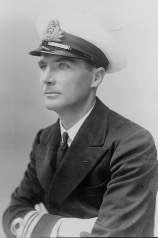Robert Ward Griffith
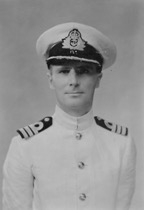
| Rank: | Commander |
| Regiment: | Royal Navy, HMS Bermuda |
| Country: | United Kingdom |
| Service Number: | Unknown |
| Cemetary/Memorial: | Plymouth Naval Memorial (Panel 78, Column 1) |
| Awards: | 1939-1945 Star 1939-1945 War Medal |
Born on 7th June 1905 in Berkshire, Commander Griffith died on 1st April 1943, lost overboard from HMS Bermuda. He was aged 37.
Son of Colonel Hugh Edward Griffith and Margaret Gwendolin Griffith. He was brother to Daisie, Rosalys, Gwendolyn and John Eaglesfield. In 1925, his younger brother died of meningitis at the age of 16 whilst at Lancing only four years after their mother. John had also been a Saint Ronan’s pupil.
He married Hazel Woods on 5th April 1929 at the British Vice Consulate in Monaco where he was stationed on HMS Warspite. In July 1940 their daughter, Liane was born while the family were living in Oxford. His son, Robin, was born in London on 7th April 1943, a week after his father’s death. He went on to attend Saint Ronan’s.
Robert entered Saint Ronan’s in September 1914 and won prizes in various subjects, including Divinity, practically every term. The prizes were beautiful bound books with the Saint Ronan’s crest on the front and inscribed inside the date and the subject that he had won. These will now be passed to his grandson, Robin.
He was made a Prefect in 1917 and upon his departure it was said: “We have always been extraordinary fortunate in our Prefects, and last term was no exception to the rule, Norwood James and Griffith formed part of a sound body of fellows, and it is in such unity as this that lies the strength of the whole establishment.”
In 1918 he won a scholarship to Osborne House which he entered in January 1919 and went on to the Royal Naval College in Dartmouth in 1920.
He regularly returned to visit Saint Ronan’s (1930, 1933, 1934,1935, 1936 and 1942) and attended the Old Ronians’ Dinner in 1930 (despite having broken his leg playing football), 1935 and 1938.
The Ronian regularly reported on his progress:
1924: “R. W. Griffith (H.M.S. Repulse), is now on a voyage round the world.”
1925: “J. W. Hale, R.N. and R. W. Griffiths, R.N., are both on board the ‘Repulse’ with the Prince” (ie Edward, Prince of Wales). Where they celebrated a ‘Crossing the Equator’ ceremony.
1935: “R. W. Griffith, R.N., who has just returned from two years service with the Mediterranean Fleet, where he was Lieutenant in charge of Torpedoes, is now going on a Staff Course for a year.”
1938: “Lt.-Commander R. W. Griffith, R.N., who has been in H.M.S. Glorious, has been on leave since she returned to home waters.”
1938: “Lieutenant-Commander R. W. Griffith, R.N., has been appointed to the Warspite.”
1940: “Commander R. W. Griffith is now home from the Mediterranean and has a job in the Admiralty.”
It also had the pleasure of recording his daughter’s victory in the annual Visitors’ Race:
1945: “Visitors’ Race: 1, Liana Griffith; 2, Sally Nalder. Liana Griffith, who is 3 1/2 ran a most valiant race to defeat Sally Nalder who was pounding along behind her and steadily catching up. It was jolly to see two of the small ones winning.”
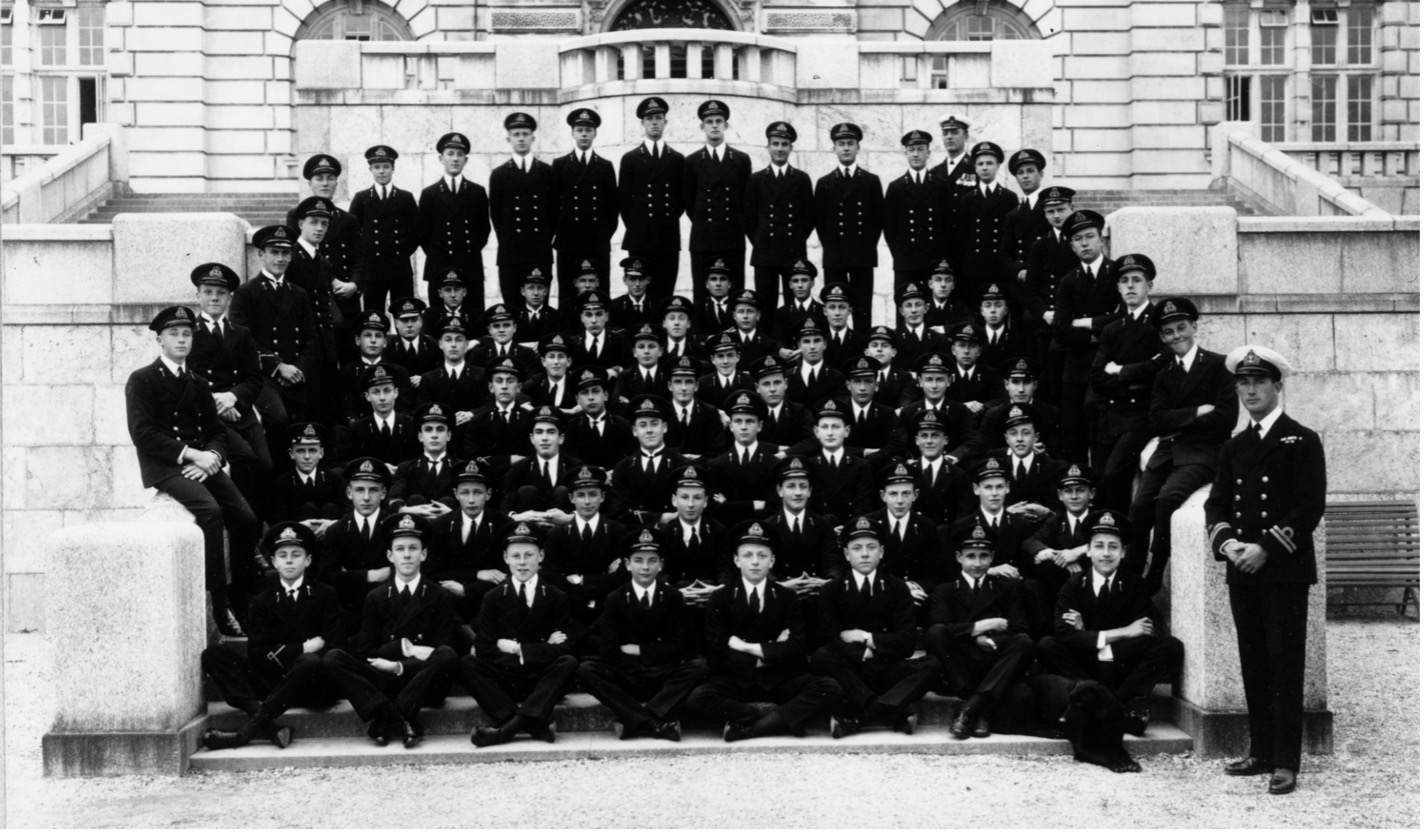
Grenville Term, Dartmouth, August 1922 (top row, right)
He entered Dartmouth in September 1920 where he was in Grenville. He left in July 1922, having passed 13th out of 65 in the passing out examination and boarded ‘The Thunderer’.
In November 1925 he was promoted to Acting Sub-Lieutenant and four months later in March 1926 to Sub-Lieutenant and in August 1927 to Lieutenant, which rank he held for eight years until being promoted to Lieutenant Commander in August 1925 and was appointed Commander in June 1939, nine months earlier than is usual.
Robert was commissioned as Commander on HMS Bermuda in 1942. Through 1942, Bermuda participated in the North Africa campaign, including Operation Torch, as part of the 10th Cruiser Squadron. With HMS Sheffield, she was detached from Force H to attack a small coastal fort, where both came under attack from Italian torpedo bombers. She covered the landing at Bougie and managed to escape heavy air attacks unscathed. Bermuda then returned to service in the Atlantic to escort ships in the Bay of Biscay.
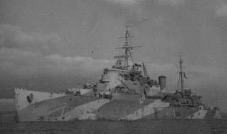
Bermuda at Scapa Flow, 1942
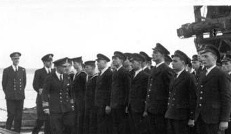
Commander Griffith inspecting his men, 1942
Commander Griffith was swept overboard during a gale whilst trying to recover paravanes (underwater devices to protect a ship against anchored contact mines). In the book “Alarm Starboard: A Remarkable True Story of the War at Sea”, written by the Commander’s ‘right hand man’, Geoffrey Brooke, he is described as being “small and easy to get along with”. Mr Brooke describes the circumstances of Commander Griffith’s death:
“We had an awful tragedy last week. The Commander and Gunnery Officer were washed overboard in a gale. The Gunnery Officer was picked up all right but not the Commander. The saddest part about it was that he was due to be relieved on the very day that he was lost, and his relief was waiting when we got back. He was an awfully nice man and it is so dreadful for his wife.
“This came when recovering paravanes. The sea was rough with a short, steep swell coming from right ahead. The Commander who was not happy with the conditions went down to give moral support. The work was virtually complete – they were ‘stopping’ the paravane towing wires to the guardrails – when the ship went ahead and turned back into the sea. As she gathered speed, the ship’s bow rose and fell two or three times and then suddenly dropped right into a mass of oncoming water. Most were able to hang on to something but the Commander, Guns, a Petty Officer and I think another were washed over the side. The last two were swept back again at once- as sometimes happens – but to everyone’s horror, the Commander and Guns were seen to be struggling in the rough water and dropping quickly astern. A Petty Officer called Scott, who happened to be painting a carley float in the waist with a couple of men quickly threw it over the side. The Captain bought the ship round In a 360 turn and thanks to the float – visible from time to time on the crest – was able to bring the ship back to the exact spot, skillfully putting her across the sea to make a lee for the luckless two. The Commander was visible for just a short time and then he disappeared.”
The story goes on to detail the rescue of the Gunnery Officer, and concludes:
“We learnt later that Commander Griffith was considered in high places to be a certainty for flag rank.”
Commander Griffith is commemorated on the Royal Naval memorial on Plymouth Hoe and there is a tree (a Pin Oak) planted in his memory in the Britannia Wood (one of the 27 woods, one for each ship of the line, planted in 2006 to commemorate the 200th anniversary of the Battle of Trafalgar, at Britannia Royal Naval College in Dartmouth.
